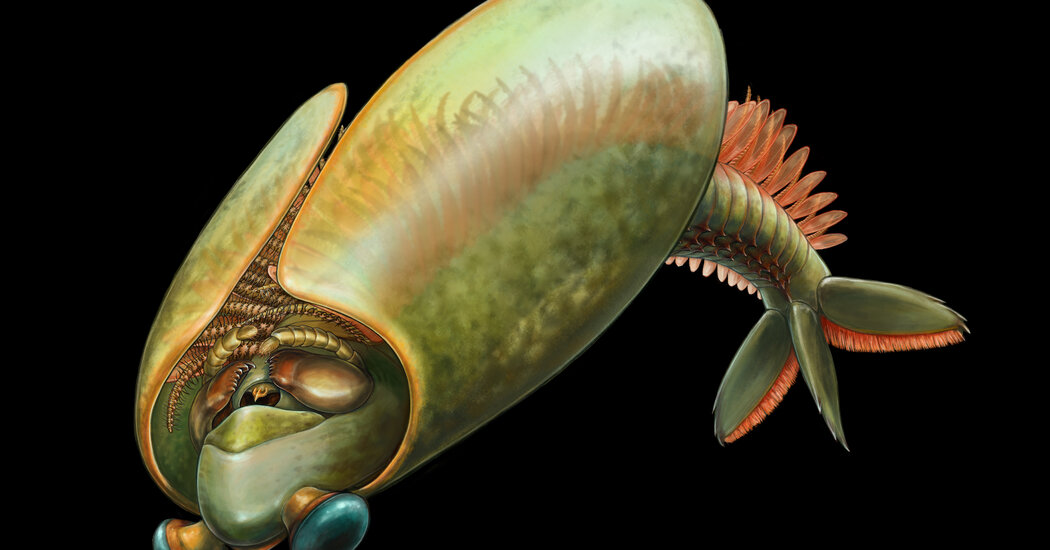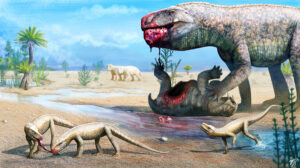About 70 percent of Earth’s animals — including centipedes and bees, shrimp and crabs — are arthropods with mandibles, or pincer-like jaws. To understand how organisms with this anatomical feature became so diverse and successful over the past 500 million years, scientists looked into the taco-like shell that protected an enigmatic creature that once swam in prehistoric seas.
This creature, the arthropod Odaraia alata, roamed the shallow seas of the Middle Cambrian period approximately 508 million years ago. Sometimes compared by scientists to modern shrimp, Odaraya was nearly eight inches long, which was large for the time. Its unique hard coating, which might remind you of Taco Tuesday, most likely helped it propel itself through the water, sometimes upside down.
A fossil analysis published Wednesday in the journal Proceedings of the Royal Society B presents the first solid evidence that Odaraya had mandibles and likely foraged in the open ocean, not just near the sea floor. The study fills critical gaps in the evolutionary record of arthropods and the establishment of marine food webs.
Paleontologists have puzzled Odaraya for more than a century. They proposed, first in 1912 and later in 1981, that the sea bug could feed by filtering with mandibles, as shrimp and crustaceans do today. But the fossil evidence was inconclusive.
“Many things about Odaraya were still a mystery to us” even after the exhaustive analysis in 1981, said Alejandro Izquierdo López, a paleontologist who led the new study while at the University of Toronto.
Dr. Izquierdo-López measured and documented 150 previously unanalyzed Odaraia alata specimens from the collections of the Royal Ontario Museum. He selected 24 exceptionally well-preserved fossils for closer examination, which yielded exquisite details of the animal’s head and legs. Such features rarely survive geological burials, but the fossils were originally found in British Columbia, Canada, in the Burgess Shale, a rock formation with unusually high levels of high-quality preservation of soft body parts. Dr. Izquierdo López’s specimens were no exception.
“I’m amazed,” said Russell Bicknell, a paleontologist at the American Museum of Natural History who was not involved in the study. “It’s just crazy how beautiful these animals are.”
The fossils had clear mandibles lined with small teeth. Between the jaws was a strange, single tooth, most likely used for grinding food.
“It looks like a trident,” said Dr. Izquierdo Lopez. “This was something not seen in other Cambrian animals.”
Dr. Izquierdo López’s analyzes also revealed that Odaraia’s “very strange” feet are covered with dozens of large spikes and hundreds of smaller spikes. The legs would come together to create a web similar to a fishing net. The animal may have used its leg cascade to channel water through its tubular shell, trapping plankton and other prey in a net. It then sent the food to its mouth, where the mandibles and teeth ground it.
Fossil finds support previous ideas that Odaraya was a filter feeder. But the relatively large gaps between the leg spikes suggest that the animal may have caught prey up to a centimeter long. Odaraya also has some of the largest eyes relative to its body size among animals of the time, a common characteristic of carnivores.
Dr. Izquierdo Lopez then suggested that Odaraia might have been part filter, part predator. “It’s an idea worth continuing to explore,” he said.
“This is an animal that uses suspension feeding, which is quite innovative for such a deep time,” Dr Bicknell said. The fossils provide “a stunning insight into how we think this kind of animal functioned.”
This flexibility could have helped Odaraia thrive in the water column, setting the stage for the evolutionary success of other mandible-bearing arthropods. Even if its taco-shaped shell no longer exists, its way of eating has survived half a billion years.
Scientists are not sure who Odaraya’s closest living relative is; the taco-shaped shell has not been seen since the animal roamed the Cambrian seas. Some forms of shrimp are potential relatives of Odaraia, but there is more to learn, said Dr. Izquierdo López.
Both paleontologists, given the opportunity, would put Odaray to a taste test.
“They were probably quite fleshy,” said Dr. Izquierdo Lopez. “I’d probably do something with parsley and garlic.”
He added: “You’re just going to have to take a lot of legs off.”
As for Dr Bicknell, who is a dual citizen of New Zealand and Australia: “Honestly? Barbie shrimp.



